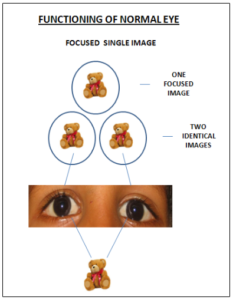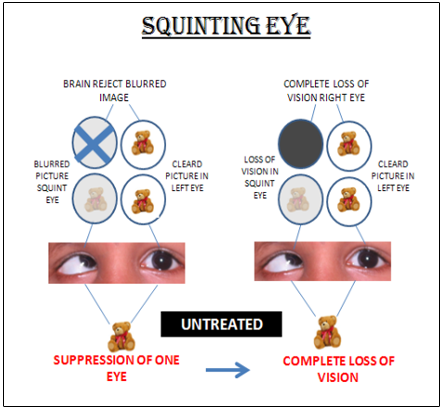Squint
- Services
- Squint
Facility – Strabismus
Strabismus is a condition in which the eyes are misaligned and point in different directions. One eye may look straight ahead, while the other eye turns inward, outward, upward or downward. You may always notice the misalignment, or it may come and go. The turned eye may straighten at times and the straight eye may turn.
Strabismus is a common condition among children. It occurs equally in males and females. Strabismus may run in families. However, many people with strabismus have no relatives with the problem.
How do the eyes work together?
With normal vision, both eyes focus at the same spot. The brain then fuses the two pictures into a single three-dimensional image. This three-dimensional image gives us depth perception. When one eye turns, two different pictures are sent to the brain. In a young child, the brain learns to ignore the image of the misaligned eye and sees only the image from the straight or better eye. The child then loses depth perception and the unused eye becomes a lazy eye (AMBLYOPIA).
Adults who develop strabismus often have double vision because the brain is already trained to receive images from both eyes and cannot ignore the image from the turned eye.
What Causes strabismus?
The exact cause of strabismus is not fully understood. Six eye muscles, controlling each eye movement, are attached to the outside of each eye. In each eye, two muscles move the eye right or left. The other four muscles move it up or down or rotate the eye.
To line up and focus both eyes on a single target, all the muscles in each eye must be balanced and work together, the muscles in both eyes must be coordinated. The brain controls the eye muscles.
Conditions causes Squint
- By Birth
- Hereditary
- Injury
- Cataract
- High refractive error in one eye
Amblyopia / Lazy Eye
Good vision develops during childhood when both eyes have normal alignment. Strabismus may cause reduced vision, or amblyopia, in the weaker eye. The brain will recognize the image of the better-seeing eye and ignore the image of the weaker or amblyopic eye. This occurs in approximately half the children who have strabismus. Amblyopia can be treated by patching the “good” eye to strengthen and improve vision in the weaker eye. If amblyopia is detected in the first few years of life, treatment is usually successful. If treatment is delayed until later, i.e. > 10 years, amblyopia usually becomes permanent. As a rule, earlier the amblyopia is treated, the better the visual result.
What are the symptoms of strabismus?
Strabismus
Treatment for strabismus works to:
- Improve and preserve vision
- Straighten the eyes
- Restore binocular (two-eyed) vision 3-D vision.
After a complete eye examination, an ophthalmologist can recommend appropriate treatment.
In some cases, eyeglasses can be prescribed for your child. Other treatments may involve surgery to correct the unbalanced eye muscles or to remove a contract. Covering or patching the strong eye to improve amblyopia is often necessary.
The eyeball is never removed from the socket during any kind of eye surgery. The ophthalmologist makes a small opening in the tissue covering the eye to reach the eye muscles. Certain muscles are repositioned during the surgery, depending on which direction the eye is turning. It may be necessary to perform surgery on one or both eyes. When squint surgery is performed on children, a general anaesthetia is required.
Local anesthesia is an option for adults.
Recovery time is rapid. People are usually able to resume their normal activities within a few days. After surgery, glasses or prisms may be useful. In some cases, further surgery may be needed at a later stage to keep Eyes.
Surgery done as early as possible gives the chance for the child to develop good binocular vision and surgical results are best obtained in childhood .as children grow older the binocular vision may not be restored and it becomes more of cosmetic surgery.
Strabismus surgery is safe and effective treatment for eye misalignment. Early the squint is diagnosed and treated the better are the results.
Myths Vs Facts
- MYTH: Children will outgrow squint
FACT: Children with true squint will never outgrow it
- MYTH: Children with squint are lucky
FACT: Children with squint are in fact unlucky because they have no binocular vision, they have vision only in one eye and they are teased by their friends and peers and grow up to be introverts
- MYTH: Squint surgery should be done after child grows older
FACT: Earlier the squint surgery is performed the better are the chances for the eyes to align and allow the brain develop binocular vision.
Videos
Make An Appointment
By Filling the form
Opening Hours
- 10.00 AM - 08.00 PM
- 09.30 AM - 05.00 PM
- Holiday
For Online Consultation
Make Appointment
- 10.00 AM - 08:00 PM , Monday - Friday
- 9.30 AM - 05:00 PM , Saturday
- Holiday , Sunday
- https://bit.ly/3rkHIwO







